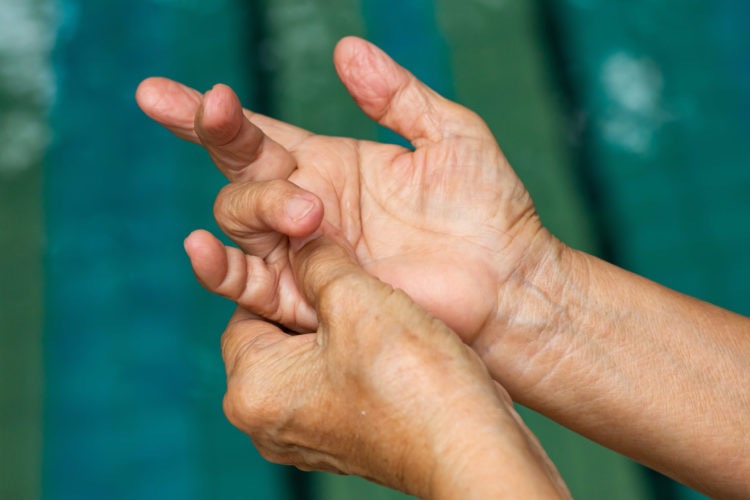Georgios Panagopoulos MD | Orthopaedic Surgeon

Table of contents
What is trigger finger?
Trigger finger, otherwise called stenosing tenosynovitis, occurs when your finger(s) gets stuck in a bent position – as if squeezing a “trigger.” Trigger finger can occur in one or more fingers. The ring finger is often one of the fingers affected. When it involves the thumb, it is called trigger thumb. Your finger may bend or straighten with a snap — like a trigger being pulled and released.

What causes trigger finger?
In the hand, tendons and muscles must work together to flex and straighten your fingers. Tendons are fibrous cords that attach muscle to bone. Usually, tendons slide easily in their individual surrounding protective sheath, called a “tendon sheath”. The sheath keeps the tendons in place next to the bones of the finger, preventing “bowstringing” of the tendon. With trigger finger, the tendon sheath becomes irritated and inflamed. This interferes with the normal gliding motion of the tendon through the sheath. As a result, the tendon gets stuck. A nodule or bump may also form on the tendon, which makes gliding of the tendon through its sheath more difficult.

Etiology is not very clear. Trigger finger is more common in women and patients with diabetes, hypothyroidism and rheumatoid arthritis.
Congenital trigger thumb
Trigger finger can also occur in children, especially in the thumb (congenital trigger thumb). This is a different entity than adult triggering, and is due to thickening of the FPL, or flexor policis longus. Trigger thumb can be flexible or rigid. It is not painful. Bracing can be attempted in flexible trigger thumb. Surgery is indicated if triggering persists beyond 12 months of age.
What are the symptoms and signs of trigger finger?
Signs and symptoms of trigger finger may include the following:
- Finger stiffness, especially in the morning
- A bump (nodule) or tenderness at the base of the affected finger – this is a common early sign of triggering
- Finger catching or locking in a bent position, which suddenly pops straight or you can easily straighten voluntarily with your other hand
- A popping or clicking sensation as you move your finger
- Finger locked in a bent position, which you are unable to straighten
Diagnosis
Your doctor can make the diagnosis based on your medical history and a physical exam. During the exam, your doctor will ask you to open and close your hand, checking for areas of pain, smoothness of motion and evidence of catching or locking. Your doctor will also feel the base of your finger at the palm to see if there is a lump present (nodule).
Conservative treatment
Conservative treatment may include:
- Rest. Avoid activities that require repetitive gripping, grasping or prolonged use of vibrating tools. If you can't avoid these activities, you may try padded gloves.
- Splint, especially at night to keep the finger extended for up to six weeks.
- Φυσικοθεραπεία
- Stretching exercises.
- Cortisone injection in the tendon sheath.
Cortisone is injected into the tendon sheath under ultrasound guidance. This may reduce inflammation and allow the tendon to glide freely again. This is the most common treatment, and it’s effective two thirds of the time. For people with diabetes, steroid injections tend to be less effective. You may have up to 2 injections, if you wish. Keep in mind that the 2nd injection is likely to be less effective.

Surgical Treatment
If conservative treatment fails, the next option is surgery. The surgeon preforms a small incision (about 1-1.5cm) near the base of the affected finger and releases the constricted section of tendon sheath. This procedure is called A1 pulley release and is usually done in an operating room under local anesthetic. The patient remains fully awake during the procedure and can go home shortly after the procedure. You can expect to have a small dressing for a few days after the surgery.
FAQs - Frequently Asked Questions
What is trigger finger?
Trigger finger, otherwise called stenosing tenosynovitis, occurs when your finger(s) gets stuck in a bent position
What are the symptoms?
– Pain at the base of the finger in the palm of the hand
– Painful nodule in the palm
– Inability to extend the flexed finger
– Catching or locking sensation of the finger
What causes trigger finger?
Tendon sheath gets inflamed and becomes narrower. Finger catches & locks in a flexed position.
What's the treatment?
– Cortisone injection -> effective 60-70%
– Surgical release under local anaesthetic -> A1 pulley release
Find us
Book an appointment with us today
